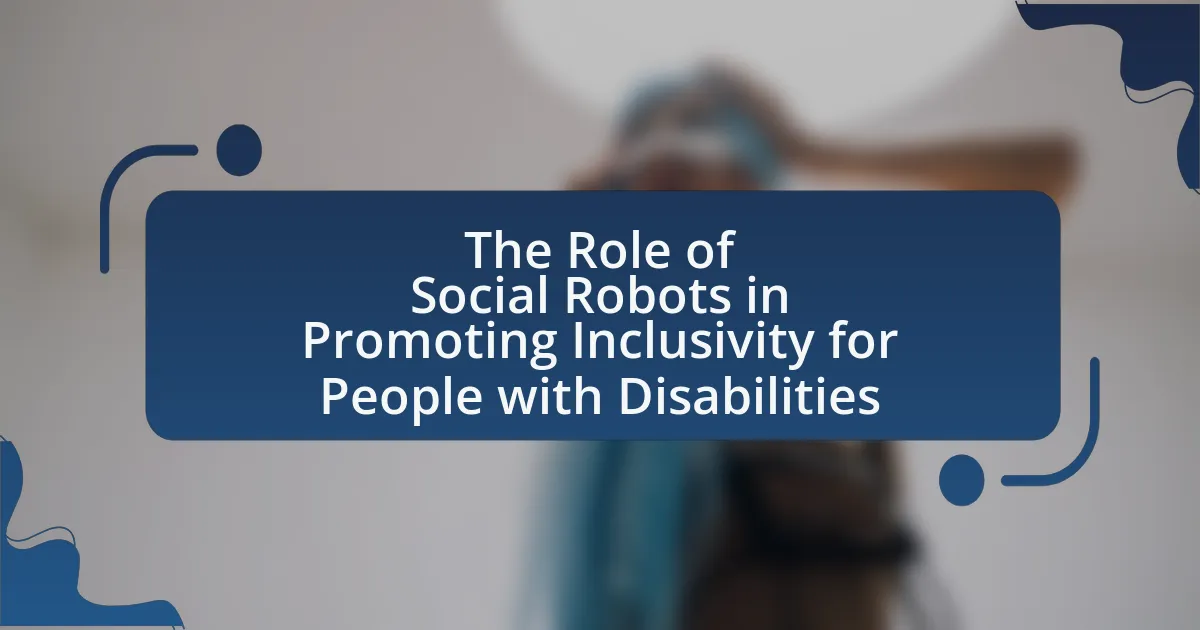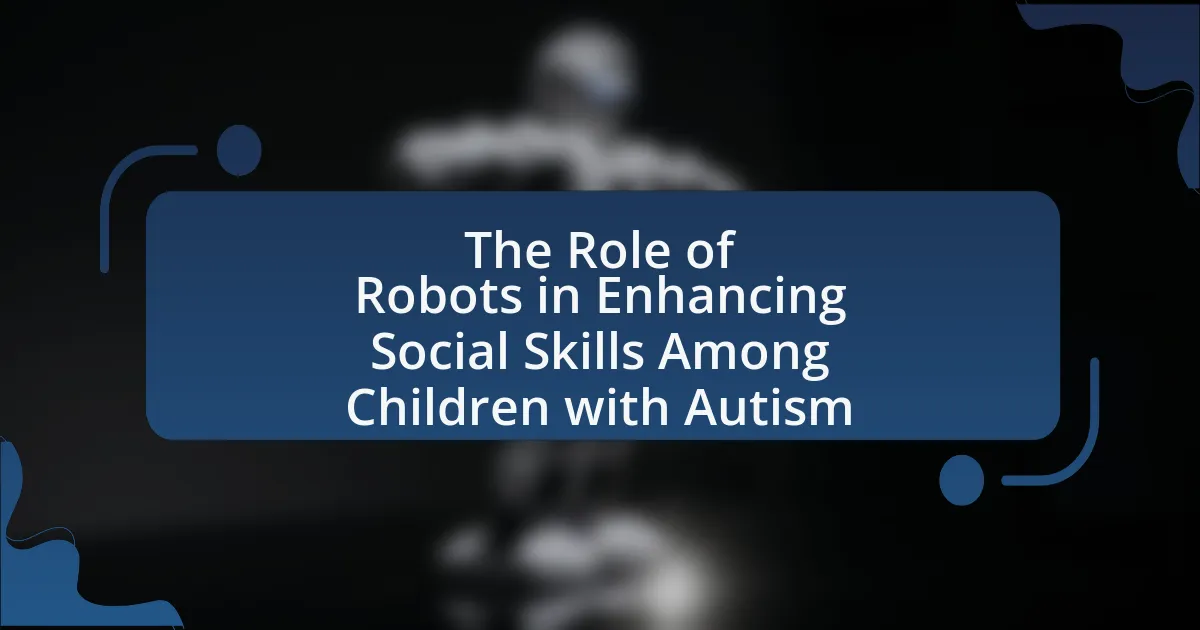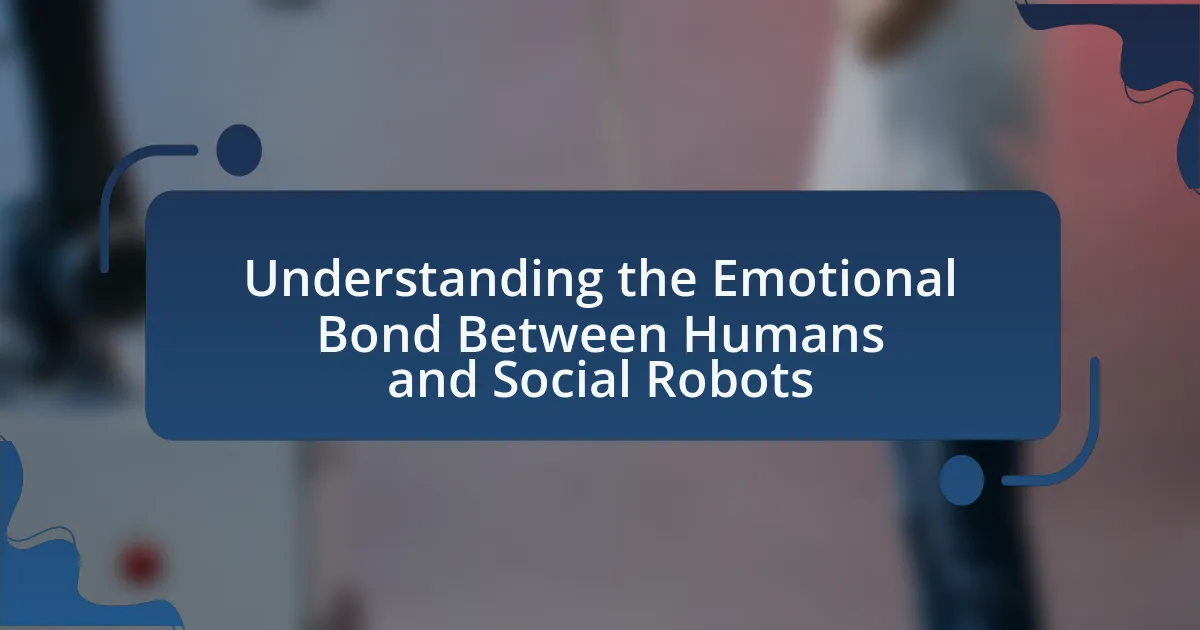The article examines the social acceptance of robots, highlighting key factors that influence public perception, including perceived usefulness, trust, emotional connection, and cultural attitudes. It discusses how cultural perceptions and societal norms shape attitudes towards robots, as well as the psychological factors that impact acceptance, such as familiarity and anthropomorphism. The role of media representation and fictional narratives in shaping public perception is also analyzed, alongside the implications of acceptance on technological development and societal benefits. Strategies to enhance acceptance, including education and public demonstrations, are outlined, emphasizing the importance of transparency and regulatory frameworks in fostering a positive relationship between humans and robots.

What factors influence the social acceptance of robots?
The social acceptance of robots is influenced by several key factors, including perceived usefulness, trust, emotional connection, and cultural attitudes. Perceived usefulness refers to how effectively a robot can perform tasks that benefit users, which directly impacts acceptance; for instance, robots that enhance productivity or safety are more readily accepted. Trust is crucial, as users must believe that robots will operate safely and reliably; studies show that higher trust levels correlate with increased acceptance. Emotional connection plays a role as well; robots that exhibit human-like traits or behaviors can foster a sense of companionship, making them more acceptable. Lastly, cultural attitudes significantly shape perceptions; societies with a positive view of technology tend to embrace robots more than those with skepticism. Research by Nomura et al. (2006) highlights that these factors collectively determine how individuals and communities perceive and accept robotic technologies.
How do cultural perceptions shape attitudes towards robots?
Cultural perceptions significantly shape attitudes towards robots by influencing how societies view technology and its role in daily life. For instance, in cultures that prioritize collectivism, such as Japan, robots are often seen as helpful companions that enhance social harmony, leading to a more positive attitude towards their integration in society. Conversely, in individualistic cultures like the United States, concerns about job displacement and autonomy can foster skepticism and fear regarding robots. Research by the Pew Research Center indicates that cultural context affects public opinion on automation, with varying levels of acceptance based on societal values and historical experiences with technology. This evidence illustrates that cultural frameworks directly impact how robots are perceived and accepted across different societies.
What role does cultural background play in robot acceptance?
Cultural background significantly influences robot acceptance by shaping individuals’ perceptions, attitudes, and expectations towards technology. For instance, cultures that prioritize collectivism may view robots as beneficial collaborators, enhancing social harmony, while individualistic cultures might focus on personal autonomy and privacy concerns regarding robotic interactions. Research indicates that in countries like Japan, where there is a high acceptance of robots, cultural narratives often depict robots as companions, contrasting with Western nations where skepticism about robots’ roles in society is more prevalent. This divergence highlights how cultural values and historical context directly affect public perception and acceptance of robotic technologies.
How do societal norms affect the perception of robots?
Societal norms significantly shape the perception of robots by influencing public attitudes and acceptance levels. For instance, cultures that prioritize technological advancement tend to view robots more positively, as seen in countries like Japan, where robots are integrated into daily life and seen as helpful companions. Conversely, societies with strong traditional values may perceive robots with skepticism or fear, often associating them with job displacement or loss of human interaction. Research indicates that societal attitudes towards technology, such as the study “Cultural Differences in Attitudes Toward Robots” by K. Dautenhahn and others, highlight how cultural context affects acceptance, demonstrating that norms dictate whether robots are embraced as tools or viewed as threats.
What psychological factors impact public perception of robots?
Psychological factors that impact public perception of robots include familiarity, trust, and anthropomorphism. Familiarity with robots can lead to increased comfort and acceptance, as studies show that repeated exposure reduces anxiety and enhances positive attitudes towards robotic technology. Trust is crucial; individuals are more likely to accept robots when they perceive them as reliable and safe, which is supported by research indicating that trust in technology correlates with its acceptance. Anthropomorphism, the tendency to attribute human-like characteristics to robots, can also influence perception; when robots exhibit human traits, people may feel more connected and accepting of them, as evidenced by studies demonstrating that human-like robots elicit more favorable responses than mechanical ones.
How does fear of job displacement influence acceptance?
Fear of job displacement significantly decreases acceptance of robots in the workplace. This fear arises from concerns that automation and robotics will replace human jobs, leading to unemployment and economic instability. Research indicates that when individuals perceive a high risk of losing their jobs to robots, they are less likely to support the integration of robotic technologies. For instance, a study by the Pew Research Center found that 72% of Americans expressed concern about job loss due to automation, which correlates with a negative attitude toward robotic adoption. This apprehension can lead to resistance against technological advancements, as people prioritize job security over potential benefits of automation.
What is the effect of anthropomorphism on robot acceptance?
Anthropomorphism significantly enhances robot acceptance by fostering emotional connections and trust between humans and robots. Research indicates that when robots exhibit human-like characteristics, such as facial expressions or social behaviors, users are more likely to perceive them as relatable and trustworthy. For instance, a study by Bartneck et al. (2009) found that participants showed increased willingness to interact with robots that displayed anthropomorphic features compared to those that did not. This effect is attributed to the psychological tendency of humans to attribute human traits to non-human entities, which can lead to more positive attitudes and increased acceptance of robotic technology in various contexts.
How does media representation affect the social acceptance of robots?
Media representation significantly influences the social acceptance of robots by shaping public perceptions and attitudes. Positive portrayals in films and television, such as friendly and helpful robots, can enhance acceptance and trust among audiences, while negative depictions, like malevolent or threatening robots, can foster fear and resistance. Research by the Pew Research Center indicates that media narratives play a crucial role in forming societal attitudes, with 72% of respondents acknowledging that media influences their views on technology. Thus, the way robots are represented in media directly correlates with their acceptance in society, as favorable representations can lead to increased comfort and willingness to integrate robots into daily life.
What types of media portrayals are most influential?
Media portrayals that are most influential in shaping public perception of robots include films, television shows, and news coverage. These forms of media often depict robots in various roles, from helpful assistants to threatening adversaries, which significantly impacts societal attitudes. For instance, films like “I, Robot” and “Ex Machina” present complex narratives that evoke emotional responses and ethical considerations regarding artificial intelligence, influencing viewers’ acceptance or fear of robots. Research indicates that positive portrayals in media can lead to increased acceptance, while negative depictions can foster anxiety and resistance, as evidenced by studies showing correlations between media consumption and public attitudes towards technology.
How do fictional narratives shape public perception of robots?
Fictional narratives significantly shape public perception of robots by influencing societal attitudes and expectations. These narratives often portray robots in various roles, from helpful assistants to dangerous adversaries, which can create a spectrum of emotional responses and beliefs about their capabilities and intentions. For instance, films like “Blade Runner” and “Ex Machina” depict robots as sentient beings, raising ethical questions and fears about autonomy, while shows like “The Jetsons” present them as benign helpers, fostering acceptance and comfort. Research indicates that exposure to positive portrayals can enhance public trust in robotic technology, while negative depictions can lead to fear and resistance, as evidenced by studies showing that individuals exposed to negative media portrayals of robots are more likely to express concerns about their integration into society.
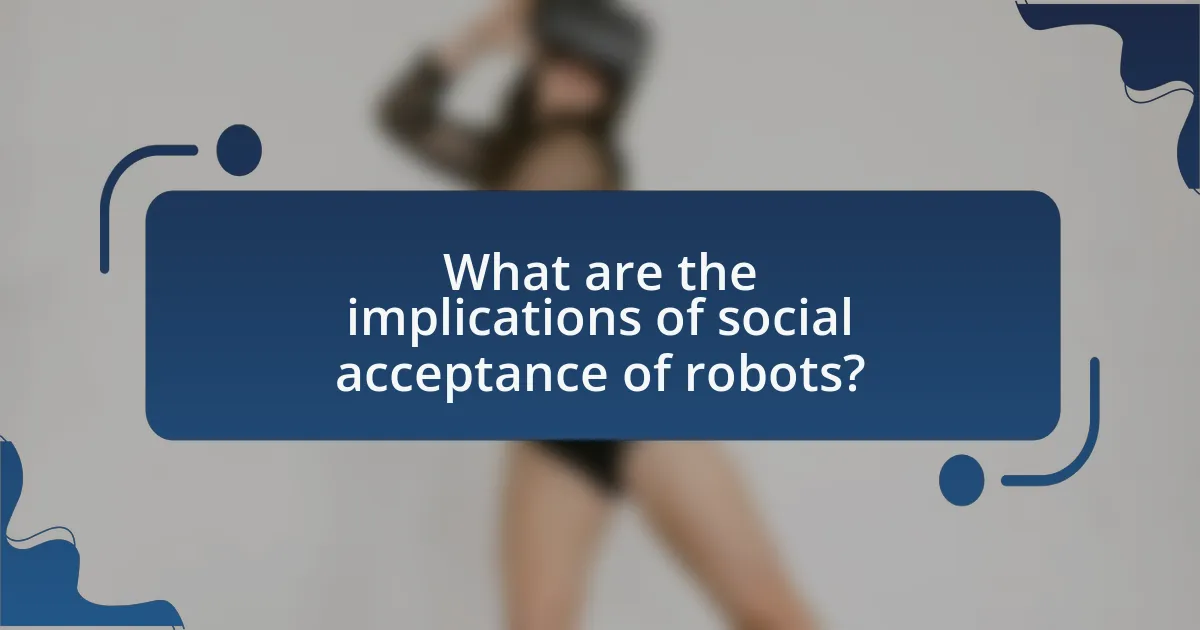
What are the implications of social acceptance of robots?
The implications of social acceptance of robots include increased integration of robots into daily life, enhanced collaboration between humans and machines, and potential shifts in labor markets. As society becomes more accepting of robots, industries such as healthcare, manufacturing, and service sectors are likely to adopt robotic technologies more widely, leading to improved efficiency and productivity. For instance, a study by the International Federation of Robotics reported that the global stock of operational industrial robots reached 2.7 million units in 2020, indicating a growing reliance on automation. Furthermore, social acceptance can influence public policy and funding for robotics research, shaping the future landscape of technology and its ethical considerations.
How does acceptance impact the development of robotic technology?
Acceptance significantly influences the development of robotic technology by shaping public perception and driving investment in research and innovation. When society embraces robots, it leads to increased funding and resources allocated to robotics projects, as seen in the rise of collaborative robots in manufacturing, which gained traction due to positive acceptance from workers and companies. Furthermore, studies indicate that higher acceptance levels correlate with greater integration of robots in daily life, as evidenced by the growing use of service robots in healthcare and hospitality sectors, where public trust has facilitated their adoption. This acceptance not only enhances the market potential for robotic technologies but also encourages developers to create more user-friendly and socially aware robots, ultimately accelerating technological advancements.
What are the consequences of low acceptance on innovation?
Low acceptance of innovation, particularly in the context of robotics, leads to stagnation in technological advancement and reduced investment in research and development. When the public is resistant to adopting new technologies, companies face diminished market demand, which discourages them from pursuing innovative projects. For instance, a study by the Pew Research Center found that 72% of Americans expressed concerns about robots taking jobs, which can hinder the integration of robotic solutions in various sectors. This reluctance not only limits the potential benefits of innovation, such as increased efficiency and improved quality of life, but also results in missed opportunities for economic growth and competitiveness in the global market.
How can acceptance levels guide future robot designs?
Acceptance levels can guide future robot designs by informing developers about user preferences and concerns, which directly influence design features and functionalities. Understanding the varying degrees of acceptance among different demographics allows designers to tailor robots to meet specific needs, enhancing usability and satisfaction. For instance, research indicates that robots designed with user-friendly interfaces and transparent functionalities are more likely to be accepted by the public, as seen in studies conducted by the Pew Research Center, which highlight the importance of trust and perceived usefulness in technology adoption. By analyzing acceptance levels, designers can prioritize features that align with societal values, ultimately leading to more successful integration of robots into everyday life.
What are the potential societal benefits of higher robot acceptance?
Higher robot acceptance can lead to increased efficiency and productivity across various sectors, including healthcare, manufacturing, and service industries. For instance, in healthcare, robots can assist in surgeries and patient care, reducing human error and improving recovery times. A study by the International Federation of Robotics indicates that automation can enhance productivity by up to 30% in manufacturing settings. Additionally, higher acceptance can foster innovation, as businesses are more likely to invest in robotic technologies, leading to job creation in tech development and maintenance. Furthermore, societal benefits include improved quality of life, as robots can take over mundane tasks, allowing individuals to focus on more meaningful activities.
How can robots improve quality of life in various sectors?
Robots can improve quality of life in various sectors by enhancing efficiency, safety, and accessibility. In healthcare, robots assist in surgeries, leading to minimally invasive procedures that reduce recovery times and improve patient outcomes. For instance, the da Vinci Surgical System has been shown to decrease complications and hospital stays. In manufacturing, robots automate repetitive tasks, increasing productivity and allowing human workers to focus on more complex roles, which can lead to job satisfaction and innovation. The automotive industry, for example, has seen a 30% increase in production efficiency due to robotic automation. In the service sector, robots provide assistance to the elderly and disabled, improving their independence and quality of life; studies indicate that robotic companions can reduce feelings of loneliness and enhance emotional well-being. Overall, the integration of robots across these sectors demonstrates a clear positive impact on quality of life through improved health outcomes, increased productivity, and enhanced social interaction.
What role do robots play in enhancing human productivity?
Robots significantly enhance human productivity by automating repetitive tasks, allowing humans to focus on more complex and creative activities. For instance, in manufacturing, robots can perform assembly line tasks with precision and speed, increasing output rates by up to 30% compared to human workers alone. This automation not only reduces the time required for production but also minimizes errors, leading to higher quality products. Additionally, studies show that workplaces integrating robots experience a 20% increase in overall efficiency, demonstrating the tangible benefits of robotic assistance in enhancing human productivity.
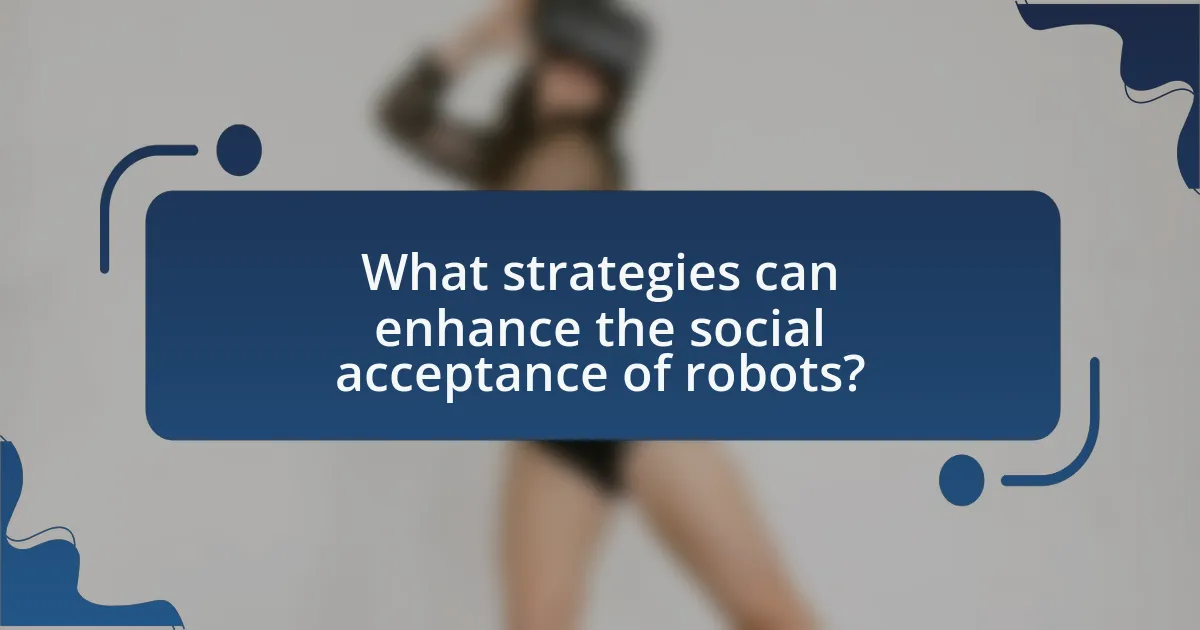
What strategies can enhance the social acceptance of robots?
To enhance the social acceptance of robots, strategies should focus on transparency, user education, and fostering human-robot interaction. Transparency involves clearly communicating the capabilities and limitations of robots, which can alleviate fears and misconceptions. User education programs can inform the public about the benefits and functionalities of robots, leading to increased familiarity and comfort. Additionally, promoting positive human-robot interactions through design and social cues can create a more relatable and approachable image of robots. Research indicates that when robots exhibit social behaviors similar to humans, such as eye contact and friendly gestures, users are more likely to accept them (Kahn et al., 2012, “Robots in the Wild: Understanding Human-Robot Interaction in the Real World,” Human-Robot Interaction).
How can education influence public perception of robots?
Education can significantly influence public perception of robots by shaping understanding and attitudes towards their capabilities and roles. When educational programs incorporate robotics into curricula, they demystify technology and foster familiarity, leading to increased acceptance. For instance, studies show that students exposed to robotics education exhibit more positive attitudes towards robots, as evidenced by research from the University of Southern California, which found that hands-on experiences with robots enhance perceptions of their usefulness and safety. This educational exposure helps reduce fear and misconceptions, ultimately promoting a more favorable public perception of robots in society.
What educational initiatives can promote understanding of robotics?
Educational initiatives that can promote understanding of robotics include hands-on robotics workshops, school curriculum integration, and community outreach programs. Hands-on workshops allow participants to engage directly with robotic systems, fostering practical skills and knowledge. Integrating robotics into school curricula enhances students’ learning experiences by providing them with foundational concepts in science, technology, engineering, and mathematics (STEM). Community outreach programs, such as robotics competitions and exhibitions, encourage public interaction with robots, increasing awareness and acceptance. Research indicates that early exposure to robotics education significantly improves students’ interest in STEM fields, as evidenced by a study from the University of California, which found that students participating in robotics programs showed a 30% increase in STEM engagement.
How can public demonstrations improve acceptance levels?
Public demonstrations can improve acceptance levels by providing firsthand experience and interaction with robots, which helps to alleviate fears and misconceptions. When individuals observe robots in action, they can witness their capabilities and safety features, leading to increased familiarity and comfort. Research indicates that direct engagement in demonstrations can significantly enhance positive attitudes toward technology; for instance, a study by Hwang et al. (2020) found that participants who attended live demonstrations of robotic systems reported a 30% increase in their acceptance levels compared to those who did not. This experiential learning fosters trust and encourages open dialogue, further contributing to a more favorable perception of robots in society.
What role do policymakers play in fostering acceptance of robots?
Policymakers play a crucial role in fostering acceptance of robots by creating regulations and frameworks that ensure safety, ethical use, and public trust in robotic technologies. They can facilitate public education initiatives that inform citizens about the benefits and risks associated with robots, thereby reducing fear and misconceptions. For instance, the European Commission has implemented guidelines for AI and robotics that emphasize transparency and accountability, which helps build public confidence. Additionally, policymakers can support research and development in robotics through funding and incentives, leading to innovations that align with societal needs and values. This proactive engagement by policymakers is essential for shaping a positive public perception of robots and their integration into daily life.
How can regulations support the integration of robots into society?
Regulations can support the integration of robots into society by establishing clear safety standards and ethical guidelines that govern their use. These regulations ensure that robots operate safely alongside humans, reducing the risk of accidents and fostering public trust. For instance, the European Union’s General Data Protection Regulation (GDPR) sets strict data privacy standards that robots must adhere to, promoting transparency and accountability in their operations. This legal framework not only protects individuals but also encourages innovation by providing a stable environment for developers and manufacturers. By addressing concerns related to safety, privacy, and ethical considerations, regulations facilitate a smoother acceptance of robotic technologies in everyday life.
What policies can mitigate fears associated with robots?
Policies that can mitigate fears associated with robots include transparency in robot design and functionality, public education initiatives, and regulatory frameworks that ensure safety and ethical use. Transparency allows users to understand how robots operate, reducing anxiety about their capabilities and intentions. Public education initiatives can inform communities about the benefits and limitations of robots, fostering a more informed perspective. Regulatory frameworks, such as safety standards and ethical guidelines, can provide assurance that robots are developed and deployed responsibly, addressing concerns about job displacement and privacy. For instance, the European Union’s General Data Protection Regulation (GDPR) includes provisions that impact the use of AI and robotics, emphasizing the importance of ethical considerations in technology deployment.
What practical steps can individuals take to embrace robots?
Individuals can embrace robots by actively engaging with robotic technologies in everyday life. This can include using home automation systems, such as smart speakers and robotic vacuum cleaners, which familiarize users with robotic functionalities. Additionally, participating in workshops or community events focused on robotics can enhance understanding and acceptance. Research indicates that hands-on experience with robots increases comfort levels and reduces anxiety towards them, as shown in studies conducted by the University of Southern California, which found that direct interaction fosters positive attitudes. Furthermore, educating oneself about the benefits and limitations of robots through credible sources can help demystify their roles in society, leading to greater acceptance.



